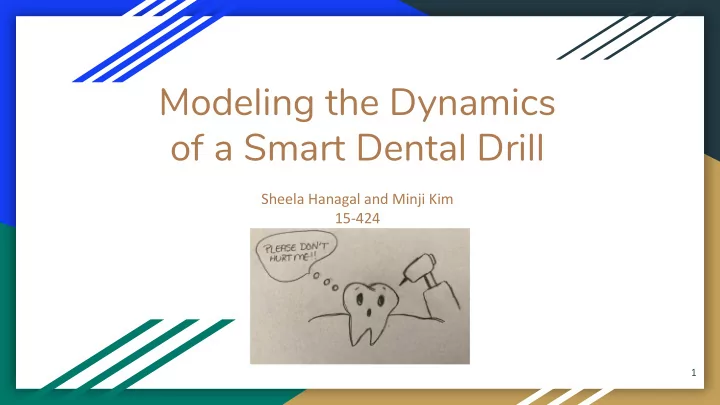

Modeling the Dynamics of a Smart Dental Drill Sheela Hanagal and Minji Kim 15-424 1
What is a Smart Dental Drill? ❖ A drill used during dental implant surgeries, which provides updates on the location of the drill in reference to the neurovascular bundle ❖ Provides an opportunity to drill deeply enough for the implant to hold while still ensuring safety 2
Why Should We Model Them? ❖ 1 million implants are inserted annually and that rate is expected to increase by 12-15% for the next several years ❖ We should use the new availability of information to guarantee that the procedure will always be safe with this new drill ❖ May lead to more successful dental implants in the future 3
Angular Motion Model ❖ Event-triggered Model ❖ Considers how angular motion of the drill affects the drill’s downward movement ❖ Friction is not considered ❖ The user adjusts torque and weight on bit (WOB) to be any arbitrary values until it wants to stop at which point both torque and WOB become 0 4
Our Control Variables and our ODEs 5
Safety Condition Explanation ❖ Ensures that the drill still hasn’t hit the neurovascular bundle and it can slow down when no more weight on bit or torque is added to not hit the bundle ❖ The change in angular velocity is a decaying function 6
Friction Model ❖ Very similar to the angular motion model ❖ Doesn’t have stick-slip motion ❖ Added friction which affects the angular velocity of the drill and thus the downward movement ❖ Distinguished between static and kinetic friction 7
Setting Friction Within Our Model 8
Time-Triggered Model ❖ A more realistic model that only allows for access to information from the drill within intervals of T seconds ❖ Upper bound on Ω and pos for simplification of proof ❖ Want to ensure that the ending position and ending angular velocity of the drill will still be safe 9
Weaker Bound (u - friction)/ Jr < 0 10
Conclusion ❖ We were able to successfully model a time-triggered smart dental drill ❖ We must always be ready for appropriate simplifications when modeling ❖ We hope with our model, dental drills can always be safely and effectively operated 11
Future Expansions ❖ Consider the drill rotary and the drill bit to be two separate parts with their own angular motion ❖ A more accurate friction model ❖ Consider not only the safety but the efficiency of the drill as well 12
Special Thanks ❖ Professor Andre Platzer ❖ Yong Kiam Tan ❖ Irene Li ❖ Andrew Sogokon 13
14
Picture Credits https://patents.google.com/patent/US3871097A/en https://www.sic-invent.com/patients/sequence/ 15
Bibliography 16
Recommend
More recommend